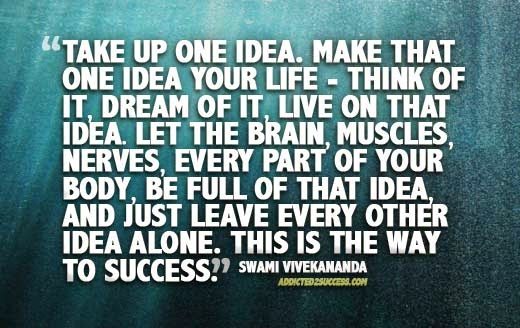Success Advice
6 Steps To Success For An Entrepreneurial Mindset

The beauty of entrepreneurialism is that there is no structured career path and certainly no guarantees.
The entrepreneurs journey involves a myriad of twists and turns complete with unexpected diverges, challenges and obstacles. That is why it is important for an entrepreneur to have a mindset that enables them to navigate the inevitable highs and lows.
For success is not a destination, it is a journey.
An entrepreneur sets up a business that will either fail or succeed. If it fails they may start another business and if it succeeds they may hold onto it for a few years before selling it, only to start all over again.
Irrespective of where you are on your entrepreneurial journey, if you are just starting out or an experienced professional here are six steps to create a mindset set for success:
1. Dance to your own tune
Be an authentic leader not a follower. It does not matter how many people do what you do, the fact of the matter is no one will do it the way you do it.
People are drawn to you for your unique gifts and talents. Learn from others whilst remaining authentic. If you are not authentic, people see straight through it.
“You will never change your life until you change something you do daily. The secret of your success is found in your daily routine” – John.C.Maxwell
2. Admire without idolising
It is inspiring to admire people for what they have achieved however it can be taken too far.
It is easy to get caught up with the success of people you admire and want to emulate them. We have the same traits as those we admire whether we see it or not.
When you put someone on a pedestal, you are also putting yourself down.
Take the time to realise where you have those same traits. Then utilise your precious time and energy to dream big, stay inspired and focus on achieving your own goals.
3. See both sides
In business and life in general, aim to see both sides. Quite often we are motivated to act by seeing the benefits over the drawbacks. This is how we make decisions, by searching for things that give us more pleasure than pain.
However, if you can take a step back and look at both sides before acting that prepares you for whatever comes your way and ensures you refrain from getting too excited or stressed. As Dr John Demartini says: “If you are too excited about something, you are not ready for it”.

4. The Power of meditation
Aim to set aside 10-20 minutes per day to quiet your mind. Meditation enables you to get to know yourself better by connecting to your soul.
This gives you access to information you will not receive by thinking logically about it.
Our mind is too busy and by quietening the mind daily it gives us the guidance and visions that are connected with our heart in order to reach our true purpose in life.
This one step alone changes your life. When we seek answers from within we are able to stay strong, live on purpose and have a greater impact in the world.
5. Appreciation
Every morning or evening, spend 5 minutes writing down everything you are grateful for in your life. We can often take things and people for granted.
By appreciating even the smallest things like a cup of coffee in the morning, a walk on the beach, or your best friend it helps us to focus on the many blessings we have right now.
As opposed to being on the continuing search of wanting more and feeling dissatisfied. This enables you to live in the present moment and ride out the waves of highs and lows.
“Be thankful for what you have; you’ll end up having more. If you concentrate on what you don’t have, you will never, ever have enough.” – Oprah Winfrey
6. Beware the seesaw of praise and criticism
The universe offers us a balance of support and challenge with 50% of the world loving us and the other 50% disliking us.
When we become reliant on external validation it makes us hungry for more and results in lessening the impact you have. It alters the message you are sending as you are overly concerned about others perception.
Likewise, understand the benefits of being criticised such as: implementing better systems for your business, creating an improved version of your keynote speech, or notice how it is helping to make you a stronger, more resilient person.
When we allow life to flow and focus on serving others, this is when we truly impact others lives and add the most value to the world.
By being less emotional, you have more vitality and a more balanced mind, which is crucial for success as an entrepreneur.
These 6 steps allow you to experience the entrepreneurial journey with fewer highs and lows.
Did You Know
How Skilled Migrants Are Building Successful Careers After Moving Countries
Behind every successful skilled migrant career is a mix of resilience, strategy, and navigating systems built for locals.

Moving to a new country for work is exciting, but it can also be unnerving. Skilled migrants leave behind familiar systems, networks, and support to pursue better job opportunities and a better future for their families. (more…)
Life
10 Research-Backed Steps to Create Real Change This New Year
This New Year could finally be the one where you break old patterns and create real, lasting change.

Every New Year, we make plans and set goals, but often repeat old patterns. (more…)
Change Your Mindset
The Silent Skill That Makes People Respect You Instantly
What truly earns respect and why most people go about it the wrong way

Everybody craves respect but not everyone earns it. Some people believe that a title, years of experience, or a position of authority automatically entitles them to respect. (more…)
Entrepreneurs
The Essential Skills Every Entrepreneur Needs In 2026
Success in the digital age isn’t about luck. It’s about mastering the skills that separate dreamers from doers.

When I was 22 years old, I started my first side hustle as a ghostwriter. (more…)
-

 Business4 weeks ago
Business4 weeks agoWhy Your E-Commerce Fulfilment Is Probably Broken (And How to Fix It)
-

 Shift Your Mindset3 weeks ago
Shift Your Mindset3 weeks ago11 E’s That Define Every Great Leader And Why Most People Miss Them
-

 Did You Know3 weeks ago
Did You Know3 weeks agoThe Success Patterns You Inherited (And Didn’t Notice)
-

 Entrepreneurs2 weeks ago
Entrepreneurs2 weeks agoThe Essential Skills Every Entrepreneur Needs In 2026
-

 Business3 weeks ago
Business3 weeks agoThe Hidden Money Pit in Your Operations (and How to Use It)
-

 Change Your Mindset2 weeks ago
Change Your Mindset2 weeks agoHow to Turn Your Mind Into Your Greatest Asset (Instead of Your Enemy)
-

 Change Your Mindset1 week ago
Change Your Mindset1 week agoThe Silent Skill That Makes People Respect You Instantly
-

 Life1 week ago
Life1 week ago10 Research-Backed Steps to Create Real Change This New Year



























3 Comments